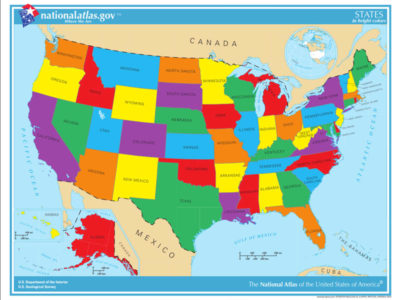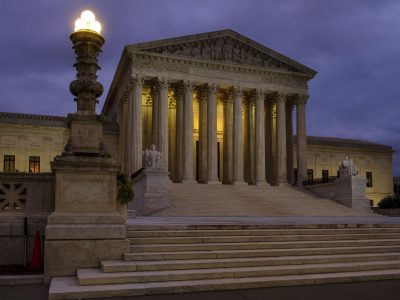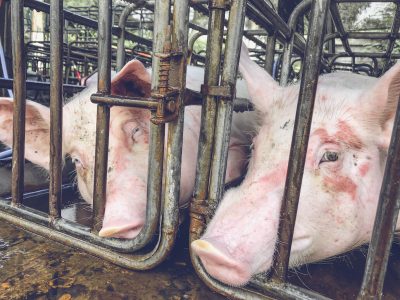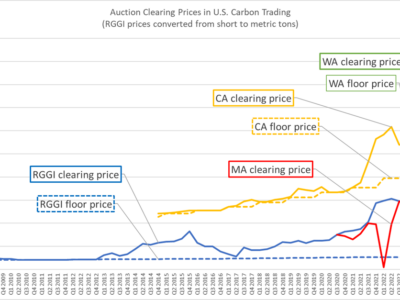states
Five Myths and Half-Truths About California Cap and Trade
California has spent years fine-tuning its trading system, with results that aren’t always easy to gauge.
A key part of California’s climate policy has always been its cap and trade system. Because the regulations aren’t very transparent, there have been a lot of misconceptions about the system. I’ve been digging into the rules, the explanatory website set up by the California Air Resources Board (CARB), and secondary sources to try to …
Continue reading “Five Myths and Half-Truths About California Cap and Trade”
CONTINUE READINGThe Changing Politics of Coal
Coal has gone from a national conservative rallying cry to a niche state concern.
The “War Against Coal” was a major conservative theme eight years ago. Now it seems almost forgotten even by Donald Trump, who was once coal’s caped crusader. But although protecting coal production is no longer much of a national issue, keeping coal-fired power plants open has percolated as an issue at the state level. It …
Continue reading “The Changing Politics of Coal”
CONTINUE READINGHave We Begun the Third Age of Climate Law?
Some thoughts for Environmental History Week.
An international agreement in 1992 committed the world’s nations to addressing climate change but contained few specifics. The US ratified that agreement, but there was little concrete action here through the end of the 20th Century. As this century began, things looked optimistic, with both presidential candidates favoring reductions in carbon emissions. Promptly after taking …
Continue reading “Have We Begun the Third Age of Climate Law?”
CONTINUE READINGState Government Standing and Environmental Law
The Supreme Court seems to be cooling to the idea of empowering state AGs.
Massachusetts v. EPA, the cornerstone climate case, contains an extensive discussion of standing which opens by saying that lawsuits by state governments are entitled to “special solicitude.” In the last few weeks of its term, the Supreme Court opined repeatedly on state standing. “Special solicitude” seems to be on the wane. Overall, I that might …
Continue reading “State Government Standing and Environmental Law”
CONTINUE READINGHas the Supreme Court Declared Open Season on Interstate Commerce?
How to read a baffling Supreme Court ruling.
If you’re a lawyer or a lower court judge, you know you’ve got a problem when the Supreme Court’s opinion begins with a list of parts of the opinion that do or don’t have a majority, along with a list of what different permutations of judges said what about the issues. The Pork Producers case …
Continue reading “Has the Supreme Court Declared Open Season on Interstate Commerce?”
CONTINUE READINGTaming the Dormant Commerce Clause
A new Supreme Court opinion is good news for state climate regulators.
Although the Constitution does not say so directly, the Supreme Court has said there are implied limits on state regulations that interfere with interstate commerce.. This is known as the dormant commerce clause doctrine. State clean energy laws have been bedeviled by challenges based on this doctrine. The Supreme Court has just made it easier …
Continue reading “Taming the Dormant Commerce Clause”
CONTINUE READINGU.S. Climate Law: A Broad & Rapidly Growing Field
There’s a lot of law relating to climate change. A lot!
In preparing to teach a course on climate law, I was really struck by how broad and rich the field has become. Back in the day, it was nearly all international law, but nowadays there’s a huge amount of U.S. domestic law. Most people, even those who work on the field, tend to focus on …
Continue reading “U.S. Climate Law: A Broad & Rapidly Growing Field”
CONTINUE READINGDo Climate Change Cases Belong in Federal Court? The Biden Administration Weighs In.
In a very narrowly argued brief, the Administration calls for returning the cases to state court.
The Biden Administration, at the Supreme Court’s invitation, has now filed a brief giving its views about current lawsuits against oil companies. The gist of the brief is that the cases belong in state court., and that the Court should let that happen rather than stepping into the litigation. The brief is right about that, …
CONTINUE READINGCap and Trade Heats Up—For Better or Worse
Prices are high and markets are proliferating as program designers lean away from the more controversial elements of carbon trading.
This past year has been big for cap-and-trade-style systems, and that momentum looks like it’s continuing in 2023. Recently, we’ve seen new programs start up in Oregon and Washington, a proposal in New York State for new carbon markets, and sustained high prices in existing programs in California and the Northeast. Although these programs differ …
Continue reading “Cap and Trade Heats Up—For Better or Worse”
CONTINUE READINGClimate Policy’s “Plan B”
As the initial top-down approach failed, a new approach to climate policy crystalized.
My last blog post told the story of the original top-down approach to climate policy. It was supposed to feature binding restrictions on carbon emissions in a global treaty and federal legislation. By 2012, it was plain that neither half of this “Plan A” strategy was in the offing. Building on trends that had begun …
Continue reading “Climate Policy’s “Plan B””
CONTINUE READING












